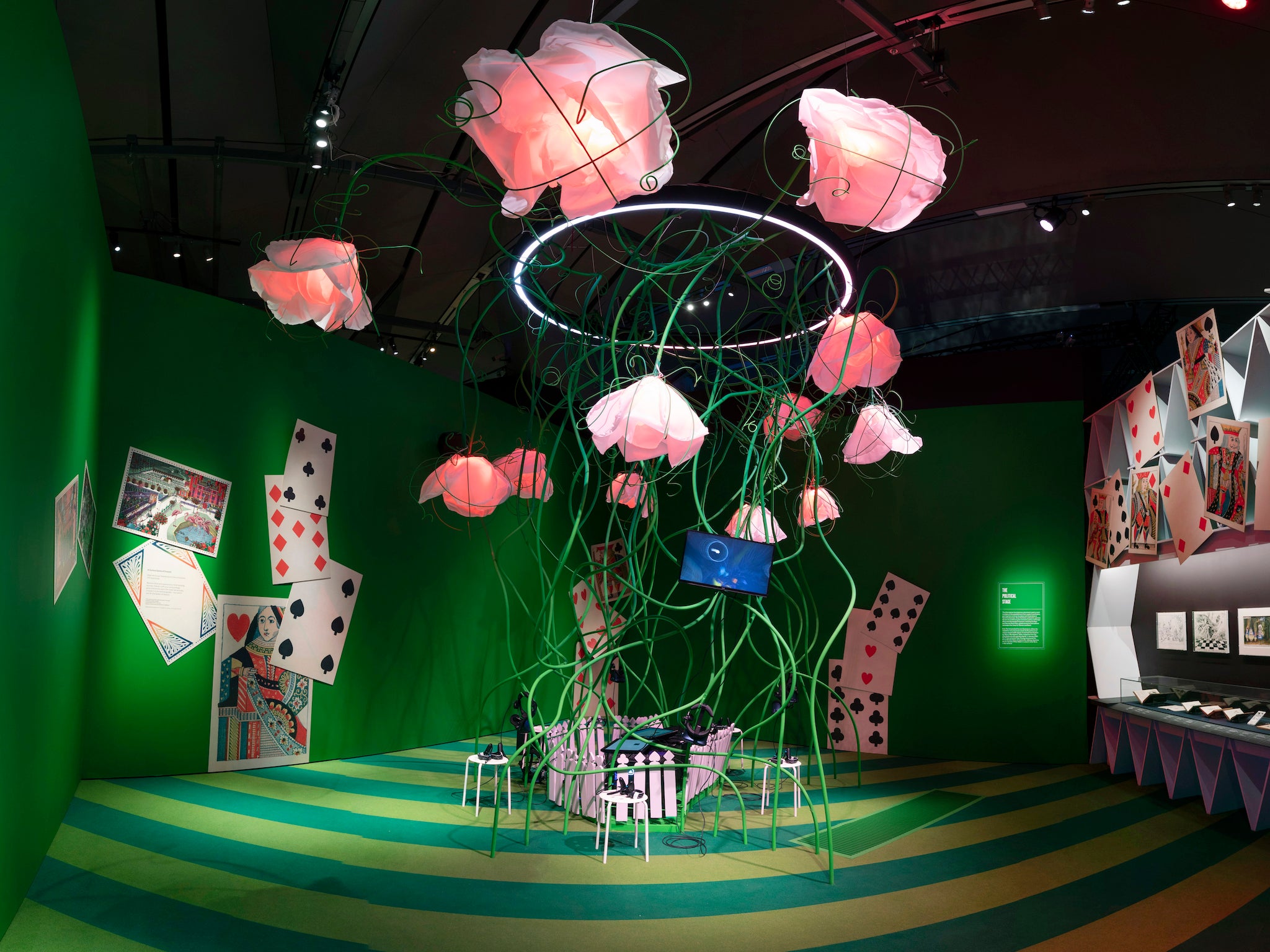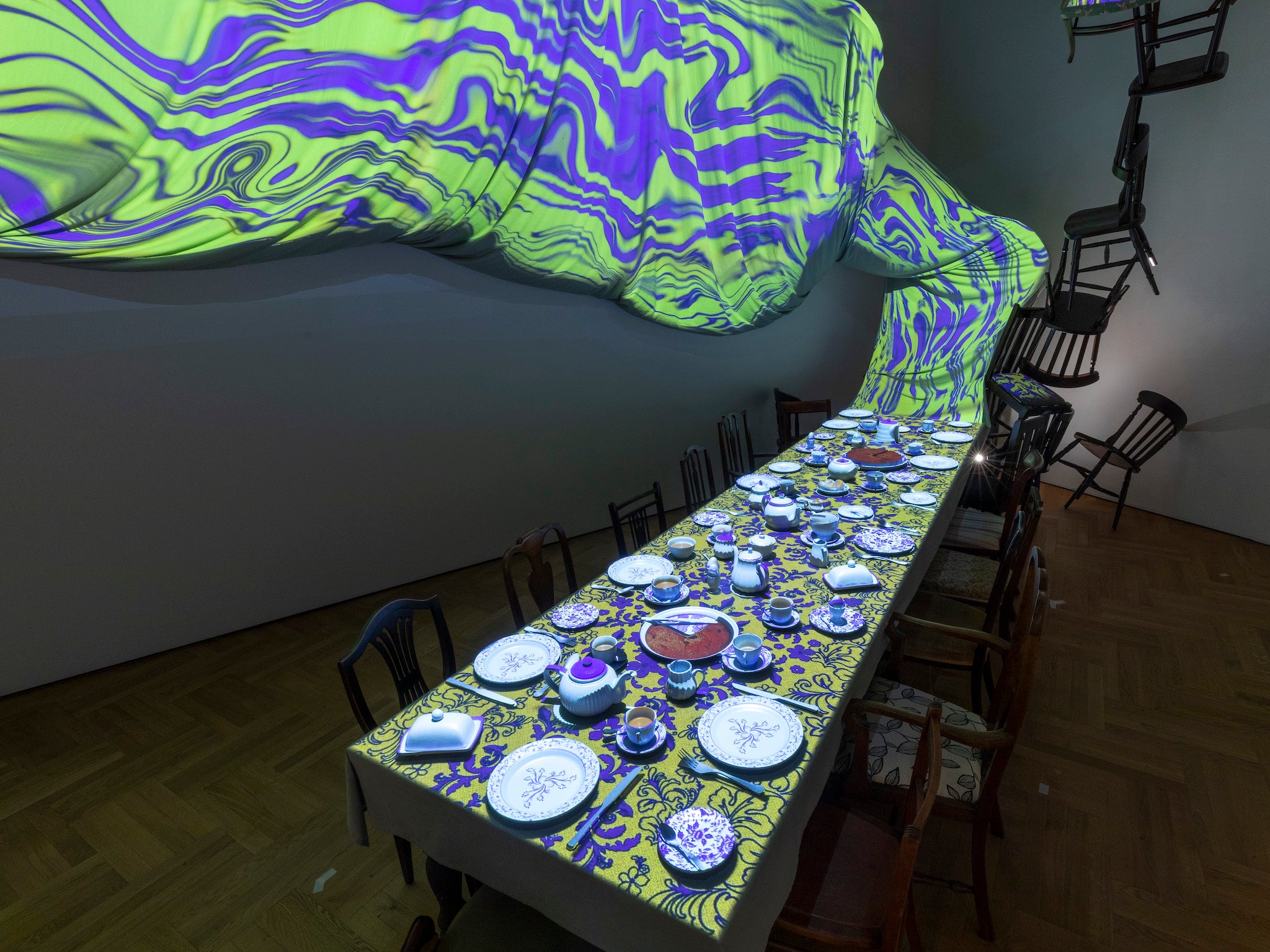Alice: Curiouser and Curiouser review – The V&A’s immersive blockbuster exhibition is a visual joy
With over 300 objects, including manuscripts, illustrations, garments and paintings, the V&A exhibition offers plenty to enjoy – though the more compelling intellectual impact of Carroll’s work is overlooked

It was during a boat trip in July 1862 that the story of a seven-year-old girl’s escapades in an imaginary world – where it is always teatime, playing chess is a death wish, and animals speak in riddles – was first told to young Alice Liddell. Oxford University don Charles Lutwidge Dodgson would three years later publish his tale Alice’s Adventures in Wonderland under the nom de plume Lewis Carroll. And in the more than 150 years since, it hasn’t been out of print.
The Victoria and Albert Museum’s blockbuster exhibition Alice: Curiouser and Curiouser celebrates the now legendary children’s book. Due to open last July, Wonderland laid in wait with its over 300 objects, including manuscripts, illustrations, photographs, garments, films and paintings, spread across five thematic rooms. Opening at last, the exhibition takes visitors on an immersive journey down the rabbit hole – one that it hopes will entice visitors back through the museum’s doors following months of closure.
The journey begins where Carroll first told his story “one golden afternoon”. Visitors peruse the photographs of collegiate Oxford that cover the walls to the sound of water lapping against an oar. An unassuming cabinet encases Carroll’s original manuscript.
The first gallery, lit with reflections from hanging metal orbs, contextualises the era, whose advances in mathematics and geometry, pre-Raphaelite art, poetry and attitudes to mental health all had a bearing on Alice’s story. It’s a relief that social distancing limits the number of visitors, so access to this label-heavy room can be enjoyed crowd-free. Notable delights include Carroll’s letters to his publishers outlining the forensic attention to detail, and illustrator Sir John Tenniel’s original line drawings.
Onward through digital psychedelic projections, sound effects and impressive set design by Tom Piper (the mastermind behind the Tower of London poppies installation), visitors weave through labyrinthine corridors to explore the cultural impact of Alice, from how it inspired popular merchandise to theatrical and cinematic interpretations. The development of film in the 20th and 21st century enabled Carroll’s imagination to reach a global audience, as directors stepped up to the challenge of depicting Wonderland through pioneering CGI technology, inventive sets and extravagant costume.
Much space is dedicated to Walt Disney’s 1951 cartoon, to this day perhaps the definitive (certainly the most ubiquitous) vision of Alice. Here, original Disney Animation celluloids show how Alice was brought to life by artist Mary Blair, whose concept art for the cult classic, inspired by Christian Dior’s 1947 New Look, is responsible for the now iconic image of Alice as a blonde girl in Baby Janes, powder blue pinafore and a black headband.
More interesting than literal adaptations of Carroll’s work is the intrigue it sparked in artists and creatives who were inspired by the book’s psychological explorations, themes of anarchy and rebellion, and its story of a little girl finding her own way. Those influenced include the surrealists Salvador Dalí and Max Ernst, musicians from The Beatles to Lady Gaga, and 1960s counterculture, which drew a link between Alice’s trippy happenings in Wonderland and hallucinogenic drug taking (1971 educational film Curious Alice had been intended to warn children about the danger of drugs but was withdrawn for fear it might appear too exciting).
Such influences are merely touched upon here, and lack more noteworthy investigation. Surrealist preoccupation with the subconscious mind and the work of long-time Alice fan Yayoi Kuasama, whose 1968 “happening” took place at the Alice in Wonderland sculpture in Central Park, are briefly skated over.

Pleasingly, fashion’s fascination with Alice is explored, including stage costumes and high-fashion creations by Vivienne Westwood and Thom Browne, and the photography of Annie Leibovitz and Tim Walker (whose all-black 2018 Pirelli calendar recreated Wonderland with the likes of Naomi Campbell and Adowa Aboah, styled by Vogue editor Edward Enniful). An entire exhibition could be dedicated to the sartorial impact alone.
The whole exhibition is a visual joy – there’s a giant toppling house of cards, a gargantuan caterpillar on stilts, Bridget Riley-style wallpaper and a VR experience in which you can play croquet with hedgehogs – but the sets are allowed to hold centre stage, often taking up entire galleries. It’s a curious decision when space is at a premium, and one that overshadows the more compelling intellectual impact of Carroll’s work.
Little is said, for example, about the darker connotations of the book: Carroll’s melancholic meditations on childhood; Freudian interpretations of Alice’s constant eating and drinking; or that Carroll, prolific photographer of girls, would rightly be viewed quite differently today. Feminist celebrations of Alice by the suffragettes as an empowered woman are touched upon, but her real impact feels lost. Equally, the “looking glass experience” in the final gallery is a fun Kusama-esque room of mirrors and projections, but the purpose beyond an Instagram opportunity feels unclear.
What is clear is that our collective fascination with this Victorian girl child has not wavered over the two and a half centuries since its publication, appealing to imaginative children, lost souls, politicians and rebel women alike. The exhibition poster, considered too dark following the pandemic, was redesigned with bright pastel lettering. In front of the large printed words “curiouser and curiouser” is the back of a diminutive Alice peering out, preparing to take her first steps into an unfamiliar world.
Alice: Curiouser and Curiouser opens on 22 May. Tickets £20. Children under 12 go free. A range of other concessions will apply. The exhibition is supported by HTC Vive Arts with further support from Unwin Charitable Trust.
Join our commenting forum
Join thought-provoking conversations, follow other Independent readers and see their replies
Comments


Bookmark popover
Removed from bookmarks